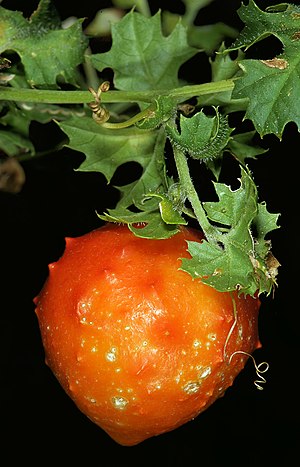Note: This is a project under development. The articles on this wiki are just being initiated and broadly incomplete. You can Help creating new pages.
Momordica balsamina
Momordica balsamina is a tendril-bearing annual vine native to the tropical regions of Africa, introduced and invasive in Asia, Australia, and Central America. It has pale yellow, deeply veined flowers and round, somewhat warty, bright orange fruits, or "apples". When ripe, the fruits burst apart, revealing numerous seeds covered with a brilliant scarlet, extremely sticky coating. The balsam apple was introduced into Europe by 1568 and was used medicinally to treat wounds.[citation needed] In 1810, Thomas Jefferson planted this vine in his flower borders at Monticello along with larkspur, poppies, and nutmeg.
Contents
- 1 Uses
- 2 Parts Used
- 3 Chemical Composition
- 4 Common names
- 5 Properties
- 6 Habit
- 7 Identification
- 8 List of Ayurvedic medicine in which the herb is used
- 9 Where to get the saplings
- 10 Mode of Propagation
- 11 How to plant/cultivate
- 12 Commonly seen growing in areas
- 13 Photo Gallery
- 14 References
- 15 External Links
Uses
anthelminthic , fever, uterine bleeding, syphilis, rheumatism, hepatitis, skin disorders.
Parts Used
Chemical Composition
The essential oil obtained from the seeds of Momordica charantia was analyzed by GC/MS. Twenty-five components, representing 90.9% of the oil, were identified. The main constituents were trans-nerolidol, apiole, cis-dihydrocarveol and germacrene D. [1]
Common names
| Language | Common name |
|---|---|
| Kannada | Huchhu thonde balli, Kaarchi balli |
| Hindi | बाड़ करेलिया Bad kareliya, बड़ा करेला Bara-karela, जंगली करेला Jangli-karela, Kankero, मोखा Mokha |
| Malayalam | Undapaval, Kaippanpaval |
| Tamil | Parpakal |
| Telugu | |
| Marathi | NA |
| Gujarathi | NA |
| Punjabi | NA |
| Kashmiri | NA |
| Sanskrit | |
| English | Balsam Pear, Balsam Apple, african cucumber, southern balsam pear |
Properties
Reference: Dravya - Substance, Rasa - Taste, Guna - Qualities, Veerya - Potency, Vipaka - Post-digesion effect, Karma - Pharmacological activity, Prabhava - Therepeutics.
Dravya
Rasa
Tikta (Bitter), Kashaya (Astringent)
Guna
Veerya
Ushna (Hot)
Vipaka
Katu (Pungent)
Karma
Prabhava
Habit
Identification
Leaf
| Kind | Shape | Feature |
|---|---|---|
| Simple | round in outline | 1.5-5.0 cm long and as broad, heart-shaped at base, hairless or sparsely hairy, 3-5-lobed, middle lobes broadly ovate or rhombic-ovate |
Flower
| Type | Size | Color and composition | Stamen | More information |
|---|---|---|---|---|
| Bisexual | broadly ovate-heart-shaped | yellow | 2.5-3.0 cm across, stalked. Male flowers are solitary, on 1.5 cm long flower-cluster-stalk, bearing near the tip a stalkless |
Fruit
| Type | Size | Mass | Appearance | Seeds | More information |
|---|---|---|---|---|---|
| Simple Fruit | broadly ovoid, narrowed at ends | 2-7 cm long, 1-2.5 cm broad | orange-red, warty | {{{6}}} |
Other features
List of Ayurvedic medicine in which the herb is used
Where to get the saplings
Mode of Propagation
How to plant/cultivate
A plant of the tropics that can be grown in subtropical and warm temperate areas. It is found at elevations from sea level to 1,465 metres, in dry to wet areas with a rainfall of 200 - 1,200 mm annually. The plant seems to be at least somewhat frost hardy [3]
Commonly seen growing in areas
Photo Gallery
References
External Links
- Ayurvedic Herbs known to be helpful to treat anthelminthic
- Ayurvedic Herbs known to be helpful to treat fever
- Ayurvedic Herbs known to be helpful to treat uterine bleeding
- Ayurvedic Herbs known to be helpful to treat syphilis
- Ayurvedic Herbs known to be helpful to treat rheumatism
- Ayurvedic Herbs known to be helpful to treat hepatitis
- Ayurvedic Herbs known to be helpful to treat skin disorders
- Herbs with Fruits used in medicine
- Herbs with Leaves used in medicine
- Herbs with Seeds used in medicine
- Herbs with common name in Kannada
- Herbs with common name in Hindi
- Herbs with common name in Malayalam
- Herbs with common name in Tamil
- Herbs with common name in English
- Habit - Herbs
- Index of Plants which can be propagated by Seeds
- Herbs that are commonly seen in the region of Lowland forest
- Herbs
- Cucurbitaceae




